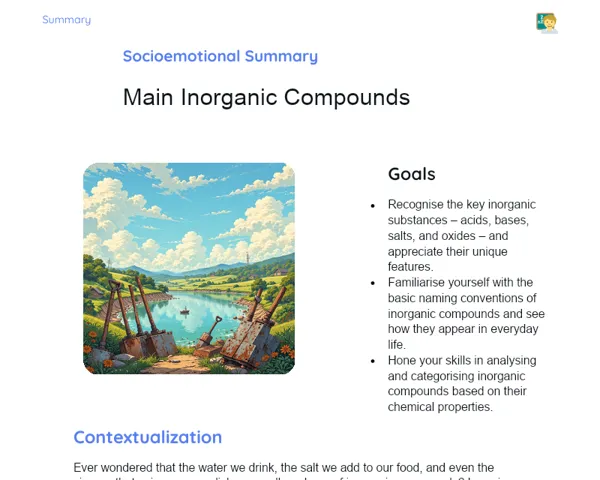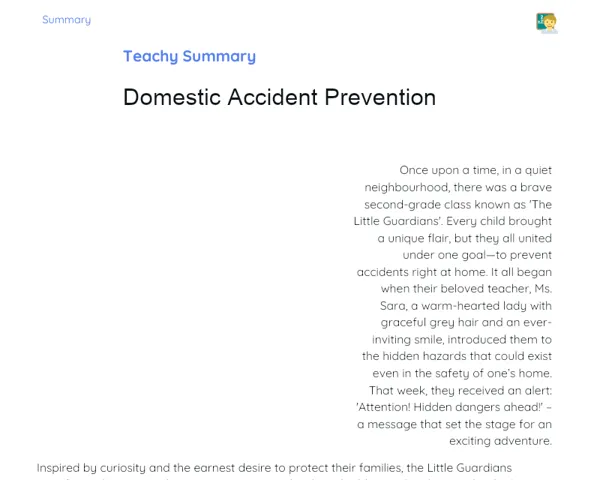Socioemotional Summary Conclusion
Goals
1. Understand what waves are.
2. Differentiate between types of waves (transverse and longitudinal).
3. Calculate the speed of a wave using the formula v = f * λ, where v is the speed, f is the frequency, and λ is the wavelength.
Contextualization
Did you know that without waves, we couldn't enjoy our favourite songs, catch the latest shows, or even have a chat on the phone? Waves are all around us, influencing everything from the sounds we hear to the light we see. Understanding how these waves operate is not only intriguing but also vital in navigating the technology-filled world we live in. So let’s embark on this wave adventure together and uncover the mysteries behind these wonderful oscillations! 🌊📡
Exercising Your Knowledge
Definition of Waves
Waves are disturbances that travel through a medium, carrying energy from one location to another without moving any physical matter. Think of tossing a stone into a pond: the ripples that spread out are waves. This concept is essential in understanding how energy, whether sound, light, or another form, moves through different mediums.
-
Energy without Matter Transport: The defining feature of a wave is that it transfers energy without moving matter from one place to another. 🌊🌟
-
Everyday Example: Water waves, sound travelling through the air, and even light are practical examples of waves. 🌊🎶💡
-
Importance in Technology: Waves are fundamental in communication, such as radio waves and mobile signals. 📡📱
Types of Waves: Mechanical and Electromagnetic
Waves can generally be divided into two categories: mechanical and electromagnetic. Mechanical waves need a physical medium to travel, like water, air, or a rope. Electromagnetic waves, however, can travel without a medium, like sunlight or radio waves.
-
Mechanical Waves: Require a medium to propagate. Example: sound waves moving through the air. 🌊🌬️
-
Electromagnetic Waves: Can travel in a vacuum without requiring a medium. Example: sunlight. 🌞💡
-
Relevance: Understanding these wave types is crucial for grasping various forms of communication and how energy is transmitted. 📡🌐
Transverse and Longitudinal Waves
Waves can also be categorized by their motion. Transverse waves have oscillations that are perpendicular to the direction they travel, like waves on a string. Longitudinal waves exhibit oscillations parallel to their direction of travel, like sound waves that compress and rarefy air particles.
-
Transverse Waves: Oscillation is perpendicular to the direction of travel. Example: waves on a string. ⬆️➡️
-
Longitudinal Waves: Oscillation is in line with the direction of travel. Example: sound waves. ➡️➡️
-
Practical Applications: Knowing about these wave types is important in fields like sound engineering and telecommunications. 🎧📞
Frequency and Wavelength
Frequency and wavelength are vital for describing waves. Frequency refers to the number of oscillations or cycles that occur in one second, measured in Hertz (Hz). Wavelength signifies the distance between two points in adjacent cycles of a wave. These metrics are essential when calculating a wave's speed.
-
Frequency (f): The count of oscillations per second, identified in Hertz. High frequency translates to more oscillations each second. 🔄🕒
-
Wavelength (λ): The space between two corresponding points on adjacent cycles. Long wavelength corresponds to lower frequency and vice versa. 📏↔️
-
Wave Speed (v): Computed using v = f * λ. Understanding this is crucial for comprehending how sound and light travel. 🏃♂️📡
Key Terms
-
Wave: Disturbance that moves through a medium, carrying energy without relocating matter.
-
Mechanical Wave: A wave that requires a physical medium to propagate.
-
Electromagnetic Wave: A wave that can travel without a medium, even in a vacuum.
-
Transverse Wave: A wave with oscillation perpendicular to the direction of travel.
-
Longitudinal Wave: A wave with oscillation parallel to the direction of travel.
-
Frequency (f): The number of oscillations per second, measured in Hertz (Hz).
-
Wavelength (λ): The distance between corresponding points within adjacent cycles of a wave.
-
Wave Speed (v): Determined using v = f * λ, where v is speed, f is frequency, and λ is wavelength.
For Reflection
-
How can you relate your understanding of waves to developing effective communication skills in your everyday life? 📡🗣️
-
Consider a challenging situation you've faced recently. How could understanding the nature of waves and their properties have helped you navigate that situation more effectively? 🌊🧠
-
Set a goal for how you might use the concept of frequency and wavelength in a project or creative activity you enjoy. How would applying this knowledge aid your learning and personal growth? 🎨📏
Important Conclusions
-
In this lesson, we explored how waves are disturbances that travel through a medium, transferring energy without moving matter.
-
We highlighted the two primary types of waves: mechanical waves, which need a physical medium, and electromagnetic waves, which can move in a vacuum.
-
We differentiated between transverse waves, characterized by oscillation perpendicular to travel, and longitudinal waves, where oscillation is parallel to travel.
-
We recognized the significance of frequency and wavelength in describing waves and learned how to calculate wave speed using v = f * λ.
Impacts on Society
Waves significantly affect our modern lives. For instance, sound waves allow us to enjoy music and communicate, while electromagnetic waves are key for transmitting radio, television, and internet signals. Without these waves, many of the technological conveniences we rely on daily would simply not be feasible. 📻📺📡
Moreover, studying waves can bring emotional dimensions to light. Just as waves exhibit varying frequencies and lengths, our emotions too fluctuate. Appreciating these variations enhances our communication skills and helps us manage our emotions better. This contributes not only to our learning but also to a more balanced emotional state. 🧠💓
Dealing with Emotions
Let’s put the RULER method into action with a practical exercise at home. First, recognize the emotions you experienced while learning about waves – perhaps curiosity, frustration, or excitement? Understand what triggered those feelings, whether from theoretical concepts or hands-on activities. Label these emotions clearly. Express your feelings appropriately, whether by chatting with a friend or writing in a journal. Finally, regulate your emotions by cultivating strategies to maintain focus and calmness while studying. This will not only enhance your learning but also improve your emotional intelligence. 🌟🧘♂️
Study Tips
-
Regularly revisit wave concepts (mechanical and electromagnetic) and their properties, using visuals and real-life examples to reinforce your understanding. 📚
-
Practice solving problems involving the wave speed equation (v = f * λ) to build confidence and expertise in calculations. 🧠
-
Form study groups to discuss the concepts learned and engage in practical activities together, creating a supportive learning environment. 👥



